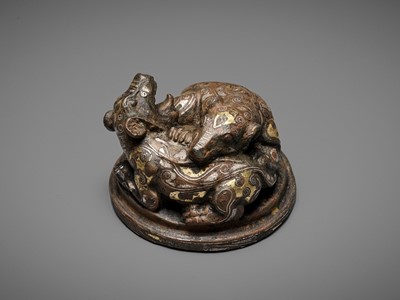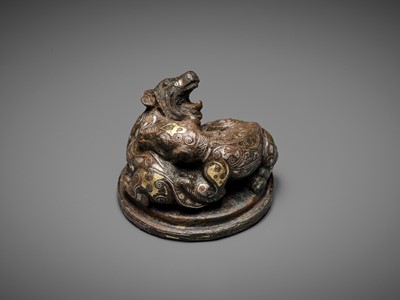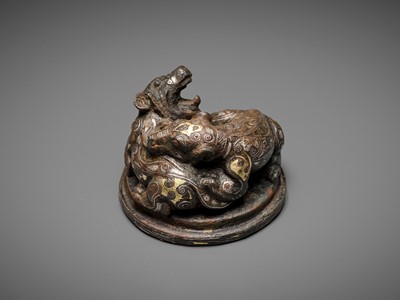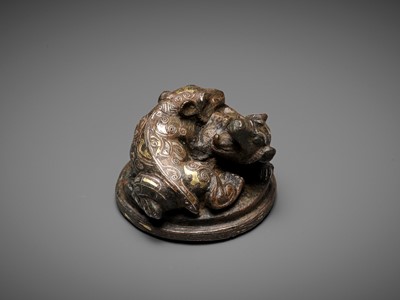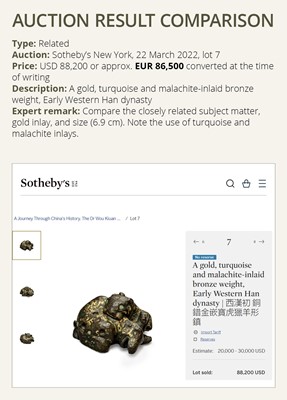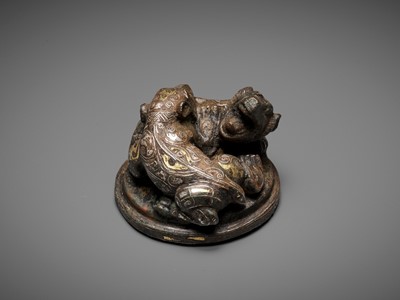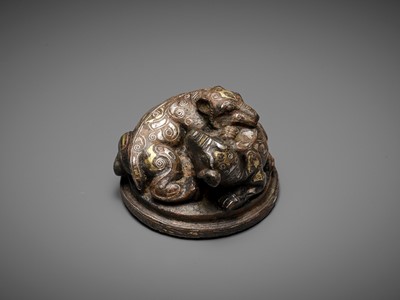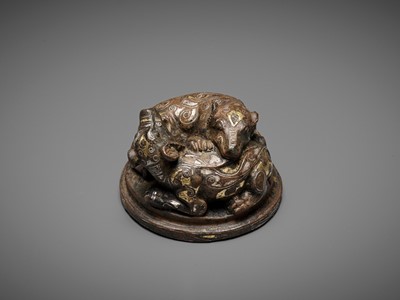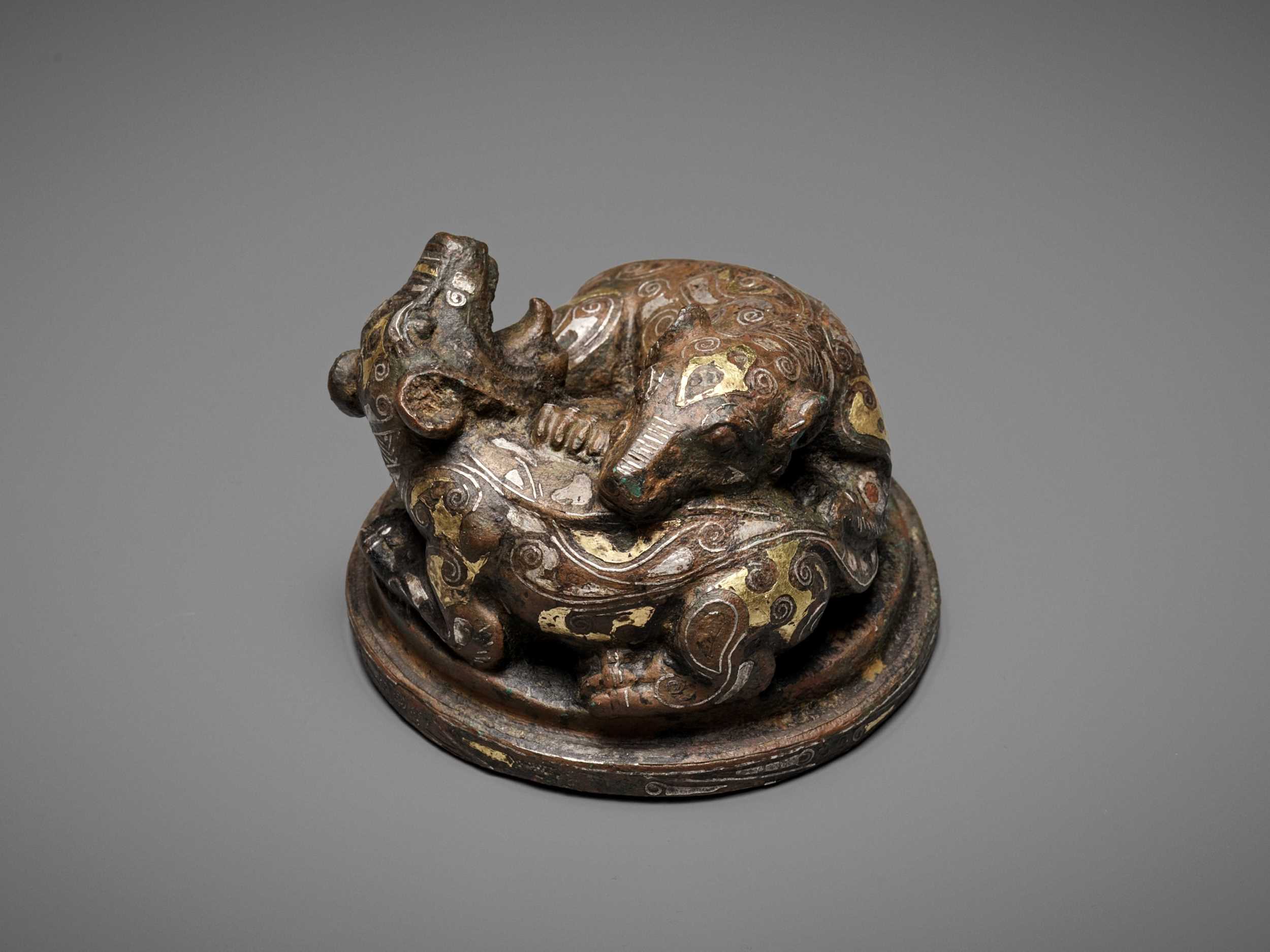2nd Jun, 2023 11:00
Fine Chinese Art / 中國藝術集珍 / Buddhism & Hinduism
128
A GOLD AND SILVER-INLAID ‘FIGHTING BEARS’ BRONZE MAT WEIGHT, WARRING STATES TO HAN DYNASTY
戰國至漢代錯金銀“斗熊”銅席鎮
Sold for €23,400
including Buyer's Premium
Opinion: While bronze mat weights from the Warring States Period or the Han dynasty are rarer and rarer to come across on the market, it has nowadays become almost impossible to find one with such well preserved and detailed inlay work. The drama of the depiction has been copied over and over during later periods, and for all kinds of purposes, but it has never been achieved again to the extent found in the present lot.
China, 5th century BC to 2nd century AD. Boldly cast as two ferocious bears locked in combat, one biting into his opponent’s back as this one roars in anguish with his tongue outstretched. Finely inlaid in gold and silver, the two animals with scroll and geometric decoration as well as subtle detailing to their bodies, the sides of the circular base with a scroll band between line borders.
Provenance: From a noted private collector in the Pacific Northwest, USA.
Condition: Superb condition, commensurate with age. Wear, signs of weathering and erosion, corrosion, malachite and cuprite encrustation, nicks, scratches, losses and cracks. The gold and silver inlays exceptionally well-preserved. A bronze weight of around 2,000 years of age or more in such well-preserved condition must be considered exceedingly rare.
Weight: 590.0 g
Dimensions: Diameter 6.7 cm, Height 5 cm
With a velvet-padded silk storage box. (2)
Mat weights crafted from precious materials such as bronze and jade, often gilded or inlaid with gold, silver or gemstones, were produced in sets of four and served a practical function of anchoring down woven mats for seating. Mats and corner-weights were believed to have been used at banquets, even those laid out in tombs. Inlaid animal-form weights were discovered in the tomb of Dou Wan, consort of Liu Sheng, Prince Jing of Zhongshan (d. 113 BC), alongside food and wine vessels.
The sculptural depiction of animals in combat was introduced to China from the nomadic and semi-nomadic cultures of Central Asia, the Eurasian steppes, and the Ordos region, and was an innovation particular to the Warring States and Han dynasty periods. During the early Western Han dynasty, the imperial Shanglin zoological park and hunting reserve adjacent to the walled city grew in size and importance. Conceived as a microcosm of the empire, it allowed the emperor and his courtiers to observe and study the various species of plants and animals known at the time. The site also served as a venue for orchestrated animal combat for the entertainment of the court.
Literature comparison: Compare a closely related silver and gold-inlaid bronze mat weight from the Han dynasty depicting a ram and tiger, illustrated by Jenkins, Mysterious Sprits, Strange Beasts, Earthly Delights: Early Chinese Art from the Arlene and Harold Schnitzer Collection, Portland, 2005, page 60, and now in the collection of the Portland Art Museum. Compare a pair of related bronze figures of tigers, with similar gold and silver inlay, but of larger size (29 cm), dated to the Warring States period, illustrated by Christian Deydier, Oriental Bronzes, XXIIIe Biennale des Antiquaires, Paris, September 2006, pages 10-21.
Auction result comparison:
Type: Related
Auction: Christie’s New York, 16 September 2010, lot 886
Price: USD 182,500 or approx. EUR 240,000 converted and adjusted for inflation at the time of writing
Description: A Rare Gold and Silver-Inlaid Bronze Tiger-Form Weight, Eastern Han Dynasty (25-220 AD)
Expert remark: Compare the similar size (6.7 cm) and purpose, and the inlay in gold and silver.
Auction result comparison:
Type: Closely related
Auction: Sotheby’s Hong Kong, 13 October 2021, lot 3674
Price: HKD 441,000 or approx. EUR 57,500 converted and adjusted for inflation at the time of writing
Description: An inscribed gold and silver-inlaid bronze weight, Han dynasty
Expert remark: Compare the closely related subject matter, dynamic posture, and size (6.8 cm). Note the different decoration, albeit still employing gold and silver inlay.
Auction result comparison:
Type: Related
Auction: Sotheby’s New York, 22 March 2022, lot 7
Price: USD 88,200 or approx. EUR 86,500 converted at the time of writing
Description: A gold, turquoise and malachite-inlaid bronze weight, Early Western Han dynasty
Expert remark: Compare the closely related subject matter, gold inlay, and size (6.9 cm). Note the use of turquoise and malachite inlays.
戰國至漢代錯金銀“斗熊”銅席鎮
中國,公元前五世紀至公元二世紀。銅鎮作兩隻正在打架的熊造型,一隻熊正雙目圓睜,雙耳後抿,寬鼻闊嘴,回首咆哮;另一隻咬住對手的後背。細部刻畫入微。通體採用錯金銀工藝。形小而氣勢雄渾,造型生動自然,十分精緻。
專家注釋:戰國或漢代的青銅席鎮在市場上越來越少見,幾乎找不到一件保存完好且鑲嵌工藝如此精湛的青銅席鎮。
來源:美國太平洋西北部知名私人收藏。
品相:狀況極佳,與年代相符。有磨損、風化和侵蝕、紅綠色結殼、刻痕、劃痕、缺損和裂縫的跡象,金銀鑲嵌保存完好,實爲罕見。
重量:590.0 克
尺寸:直徑6.7 厘米,高5 厘米
天鵝絨襯墊的真絲儲物盒。(2)
席鎮多由銅和玉石等材料製成,通常鎏金或錯金銀或鑲嵌寶石,一般一套為四件,古人就在蓆子的四角放置鎮,用來壓席,席鎮便應運而生。在漢代中山王劉勝的妃子竇琬(公元前 113 年逝世)的墓中發現了的動物形席鎮以及食物和酒器。
戰鬥中的動物造型是從中亞、歐亞草原和鄂爾多斯地區的游牧和半游牧文化傳入中國的,戰國和漢代的創新。西漢初期,毗鄰城牆的皇家上林園和狩獵區的規模和重要性日益增加,為皇帝和他的朝臣可以觀察和研究當時已知的各種動植物提供了機會。當時還出現了動物打鬥場所,供娛樂消遣。
文獻比較:比較一件非常相近的漢代公羊和老虎錯金銀銅席鎮,見Jenkins,Mysterious Sprits,Strange Beasts,《Earthly Delights: Early Chinese Art from the Arlene and Harold Schnitzer Collection》,波蘭,2005年,頁60,現收藏於波蘭藝術博物館。比較一對相近的戰國時期老虎青銅席鎮,相似的錯金銀,但尺寸較大(29 厘米),見Christian Deydier,《Oriental Bronzes,XXIIIe Biennale des Antiquaires》,巴黎,2006年9月,頁10-21。
拍賣結果比較:
形制:相近
拍賣:紐約佳士得,2010年9月16日,lot 886
價格:USD 182,500(相當於今日EUR 240,000)
描述:東漢錯金銀老虎銅席鎮
專家評論:比較相似的尺寸(6.7 厘米)和目的,以及錯金銀裝飾。
拍賣結果比較:
形制:非常相近
拍賣:香港蘇富比,2021年10月13日,lot 3674
價格:HKD 441,000(相當於今日EUR 57,500)
描述:漢代銅錯金銀熊虎鎮紙 《日利千金富》銘款
專家評論:比較非常相近的主題、動作姿態和尺寸 (6.8 厘米)。請注意不同的裝飾,但仍然採用錯金銀的製作方式。
拍賣結果比較:
形制:相近
拍賣:紐約蘇富比,2022年3月22,lot 7
價格:USD 88,200 (相當於今日EUR 86.500)
描述:西漢初期銅錯金嵌寶虎獵羊形鎮
專家評論:比較非常相近的主題、鑲嵌金和尺寸 (6.9 厘米)。請注意綠松石和孔雀石鑲嵌的使用。
Opinion: While bronze mat weights from the Warring States Period or the Han dynasty are rarer and rarer to come across on the market, it has nowadays become almost impossible to find one with such well preserved and detailed inlay work. The drama of the depiction has been copied over and over during later periods, and for all kinds of purposes, but it has never been achieved again to the extent found in the present lot.
China, 5th century BC to 2nd century AD. Boldly cast as two ferocious bears locked in combat, one biting into his opponent’s back as this one roars in anguish with his tongue outstretched. Finely inlaid in gold and silver, the two animals with scroll and geometric decoration as well as subtle detailing to their bodies, the sides of the circular base with a scroll band between line borders.
Provenance: From a noted private collector in the Pacific Northwest, USA.
Condition: Superb condition, commensurate with age. Wear, signs of weathering and erosion, corrosion, malachite and cuprite encrustation, nicks, scratches, losses and cracks. The gold and silver inlays exceptionally well-preserved. A bronze weight of around 2,000 years of age or more in such well-preserved condition must be considered exceedingly rare.
Weight: 590.0 g
Dimensions: Diameter 6.7 cm, Height 5 cm
With a velvet-padded silk storage box. (2)
Mat weights crafted from precious materials such as bronze and jade, often gilded or inlaid with gold, silver or gemstones, were produced in sets of four and served a practical function of anchoring down woven mats for seating. Mats and corner-weights were believed to have been used at banquets, even those laid out in tombs. Inlaid animal-form weights were discovered in the tomb of Dou Wan, consort of Liu Sheng, Prince Jing of Zhongshan (d. 113 BC), alongside food and wine vessels.
The sculptural depiction of animals in combat was introduced to China from the nomadic and semi-nomadic cultures of Central Asia, the Eurasian steppes, and the Ordos region, and was an innovation particular to the Warring States and Han dynasty periods. During the early Western Han dynasty, the imperial Shanglin zoological park and hunting reserve adjacent to the walled city grew in size and importance. Conceived as a microcosm of the empire, it allowed the emperor and his courtiers to observe and study the various species of plants and animals known at the time. The site also served as a venue for orchestrated animal combat for the entertainment of the court.
Literature comparison: Compare a closely related silver and gold-inlaid bronze mat weight from the Han dynasty depicting a ram and tiger, illustrated by Jenkins, Mysterious Sprits, Strange Beasts, Earthly Delights: Early Chinese Art from the Arlene and Harold Schnitzer Collection, Portland, 2005, page 60, and now in the collection of the Portland Art Museum. Compare a pair of related bronze figures of tigers, with similar gold and silver inlay, but of larger size (29 cm), dated to the Warring States period, illustrated by Christian Deydier, Oriental Bronzes, XXIIIe Biennale des Antiquaires, Paris, September 2006, pages 10-21.
Auction result comparison:
Type: Related
Auction: Christie’s New York, 16 September 2010, lot 886
Price: USD 182,500 or approx. EUR 240,000 converted and adjusted for inflation at the time of writing
Description: A Rare Gold and Silver-Inlaid Bronze Tiger-Form Weight, Eastern Han Dynasty (25-220 AD)
Expert remark: Compare the similar size (6.7 cm) and purpose, and the inlay in gold and silver.
Auction result comparison:
Type: Closely related
Auction: Sotheby’s Hong Kong, 13 October 2021, lot 3674
Price: HKD 441,000 or approx. EUR 57,500 converted and adjusted for inflation at the time of writing
Description: An inscribed gold and silver-inlaid bronze weight, Han dynasty
Expert remark: Compare the closely related subject matter, dynamic posture, and size (6.8 cm). Note the different decoration, albeit still employing gold and silver inlay.
Auction result comparison:
Type: Related
Auction: Sotheby’s New York, 22 March 2022, lot 7
Price: USD 88,200 or approx. EUR 86,500 converted at the time of writing
Description: A gold, turquoise and malachite-inlaid bronze weight, Early Western Han dynasty
Expert remark: Compare the closely related subject matter, gold inlay, and size (6.9 cm). Note the use of turquoise and malachite inlays.
戰國至漢代錯金銀“斗熊”銅席鎮
中國,公元前五世紀至公元二世紀。銅鎮作兩隻正在打架的熊造型,一隻熊正雙目圓睜,雙耳後抿,寬鼻闊嘴,回首咆哮;另一隻咬住對手的後背。細部刻畫入微。通體採用錯金銀工藝。形小而氣勢雄渾,造型生動自然,十分精緻。
專家注釋:戰國或漢代的青銅席鎮在市場上越來越少見,幾乎找不到一件保存完好且鑲嵌工藝如此精湛的青銅席鎮。
來源:美國太平洋西北部知名私人收藏。
品相:狀況極佳,與年代相符。有磨損、風化和侵蝕、紅綠色結殼、刻痕、劃痕、缺損和裂縫的跡象,金銀鑲嵌保存完好,實爲罕見。
重量:590.0 克
尺寸:直徑6.7 厘米,高5 厘米
天鵝絨襯墊的真絲儲物盒。(2)
席鎮多由銅和玉石等材料製成,通常鎏金或錯金銀或鑲嵌寶石,一般一套為四件,古人就在蓆子的四角放置鎮,用來壓席,席鎮便應運而生。在漢代中山王劉勝的妃子竇琬(公元前 113 年逝世)的墓中發現了的動物形席鎮以及食物和酒器。
戰鬥中的動物造型是從中亞、歐亞草原和鄂爾多斯地區的游牧和半游牧文化傳入中國的,戰國和漢代的創新。西漢初期,毗鄰城牆的皇家上林園和狩獵區的規模和重要性日益增加,為皇帝和他的朝臣可以觀察和研究當時已知的各種動植物提供了機會。當時還出現了動物打鬥場所,供娛樂消遣。
文獻比較:比較一件非常相近的漢代公羊和老虎錯金銀銅席鎮,見Jenkins,Mysterious Sprits,Strange Beasts,《Earthly Delights: Early Chinese Art from the Arlene and Harold Schnitzer Collection》,波蘭,2005年,頁60,現收藏於波蘭藝術博物館。比較一對相近的戰國時期老虎青銅席鎮,相似的錯金銀,但尺寸較大(29 厘米),見Christian Deydier,《Oriental Bronzes,XXIIIe Biennale des Antiquaires》,巴黎,2006年9月,頁10-21。
拍賣結果比較:
形制:相近
拍賣:紐約佳士得,2010年9月16日,lot 886
價格:USD 182,500(相當於今日EUR 240,000)
描述:東漢錯金銀老虎銅席鎮
專家評論:比較相似的尺寸(6.7 厘米)和目的,以及錯金銀裝飾。
拍賣結果比較:
形制:非常相近
拍賣:香港蘇富比,2021年10月13日,lot 3674
價格:HKD 441,000(相當於今日EUR 57,500)
描述:漢代銅錯金銀熊虎鎮紙 《日利千金富》銘款
專家評論:比較非常相近的主題、動作姿態和尺寸 (6.8 厘米)。請注意不同的裝飾,但仍然採用錯金銀的製作方式。
拍賣結果比較:
形制:相近
拍賣:紐約蘇富比,2022年3月22,lot 7
價格:USD 88,200 (相當於今日EUR 86.500)
描述:西漢初期銅錯金嵌寶虎獵羊形鎮
專家評論:比較非常相近的主題、鑲嵌金和尺寸 (6.9 厘米)。請注意綠松石和孔雀石鑲嵌的使用。
Zacke Live Online Bidding
Our online bidding platform makes it easier than ever to bid in our auctions! When you bid through our website, you can take advantage of our premium buyer's terms without incurring any additional online bidding surcharges.
To bid live online, you'll need to create an online account. Once your account is created and your identity is verified, you can register to bid in an auction up to 12 hours before the auction begins.
Intended Spend and Bid Limits
When you register to bid in an online auction, you will need to share your intended maximum spending budget for the auction. We will then review your intended spend and set a bid limit for you. Once you have pre-registered for a live online auction, you can see your intended spend and bid limit by going to 'Account Settings' and clicking on 'Live Bidding Registrations'.
Your bid limit will be the maximum amount you can bid during the auction. Your bid limit is for the hammer price and is not affected by the buyer’s premium and VAT. For example, if you have a bid limit of €1,000 and place two winning bids for €300 and €200, then you will only be able to bid €500 for the rest of the auction. If you try to place a bid that is higher than €500, you will not be able to do so.
Online Absentee and Telephone Bids
You can now leave absentee and telephone bids on our website!
Absentee Bidding
Once you've created an account and your identity is verified, you can leave your absentee bid directly on the lot page. We will contact you when your bids have been confirmed.
Telephone Bidding
Once you've created an account and your identity is verified, you can leave telephone bids online. We will contact you when your bids have been confirmed.
Classic Absentee and Telephone Bidding Form
You can still submit absentee and telephone bids by email or fax if you prefer. Simply fill out the Absentee Bidding/Telephone bidding form and return it to us by email at office@zacke.at or by fax at +43 (1) 532 04 52 20. You can download the PDF from our Upcoming Auctions page.
How-To Guides
How to Create Your Personal Zacke Account
How to Register to Bid on Zacke Live
How to Leave Absentee Bids Online
How to Leave Telephone Bids Online
中文版本的操作指南
创建新账号
注册Zacke Live在线直播竞拍(免平台费)
缺席投标和电话投标
Third-Party Bidding
We partner with best-in-class third-party partners to make it easy for you to bid online in the channel of your choice. Please note that if you bid with one of our third-party online partners, then there will be a live bidding surcharge on top of your final purchase price. You can find all of our fees here. Here's a full list of our third-party partners:
- 51 Bid Live
- EpaiLive
- ArtFoxLive
- Invaluable
- LiveAuctioneers
- the-saleroom
- lot-tissimo
- Drouot
Please note that we place different auctions on different platforms. For example, in general, we only place Chinese art auctions on 51 Bid Live.
Bidding in Person
You must register to bid in person and will be assigned a paddle at the auction. Please contact us at office@zacke.at or +43 (1) 532 04 52 for the latest local health and safety guidelines.
